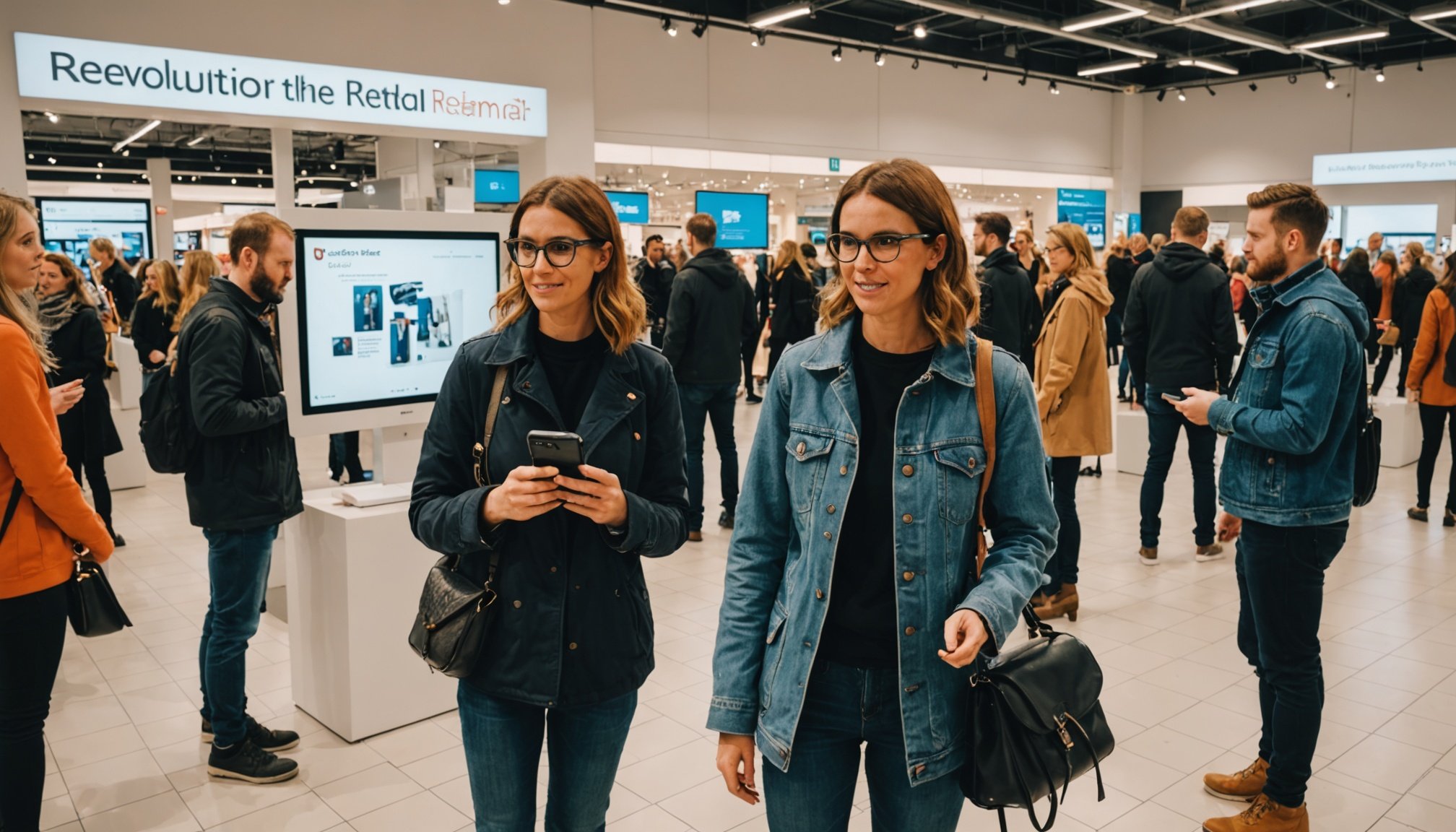Overview of Augmented Reality in Retail
Augmented reality (AR) technology represents a significant leap in retail innovation. By blending digital content with the physical world, it offers a hybrid experience that can transform how customers interact with products. An essential application of AR in the retail sector is AR try-ons, allowing customers to virtually try products like clothing, accessories, and cosmetics, offering a convenience previously unattainable.
Incorporating retail technology like AR enables businesses to engage customers more effectively. When customers can visualise how a product looks or feels before purchasing, their confidence in buying increases, which can subsequently boost sales. This technology not only enriches the shopping experience but also provides a tailored approach to meet individual customer needs.
Also to discover : Revolutionizing healthcare: how sheffield providers are harnessing telehealth innovations to enhance patient care
Furthermore, AR contributes significantly to customer satisfaction by offering interactive and personalized shopping experiences. For retailers, embracing augmented reality in retail also means gaining a competitive edge, as it differentiates their offerings from traditional retail methods. As a result, AR doesn’t just enhance customer experience but also drives market growth and innovation within the sector. Through engaging visual methods and improved accessibility, AR is fundamentally reshaping the retail landscape.
Benefits of AR Try-Ons for Retailers and Shoppers
Augmented Reality (AR) try-ons are revolutionising the retail landscape by enhancing customer engagement and satisfaction. By allowing shoppers to virtually interact with products before purchasing, AR try-ons significantly improve the shopping experience. This innovative approach mitigates common shopping frustrations like uncertainty in fit or product functionality.
Have you seen this : Unlocking exceptional customer experiences: proven techniques for manchester”s premier spa
One of the principal advantages of AR try-ons is their ability to reduce return rates. When customers are confident about what they’re buying, they’re less likely to return items. This reduces the logistical burden on retailers and leads to satisfaction for customers, knowing they’ve made a well-informed purchase.
Furthermore, AR try-ons are vital in increasing consumer engagement. By offering interactive and immersive experiences, retailers can captivate their audience, fostering a stronger connection with their brand. This often results in longer shopping sessions and enhances brand loyalty, as customers are more likely to revisit and recommend a retailer that offers these advanced services.
From a business perspective, AR try-ons can lead to significant boosts in sales and conversion rates. As the barrier between shopping and purchasing is lowered, customers are more inclined to buy, resulting in improved retail sales performance. By leveraging AR technology, retailers stand to benefit from a competitive edge in today’s market.
Case Studies: Successful Implementation of AR in Leeds Retail
Augmented Reality (AR) is transforming the retail experience in Leeds, with many retailers embracing this technology. Notably, local retail innovation has sparked interest. Success stories are abundant, particularly among those adopting AR try-ons.
A prime example is a leading Leeds clothing store that introduced AR virtual fitting rooms. Customers could visually try on outfits without physically changing. As a result, sales increased by 27%, showcasing the technology’s effectiveness. Moreover, customer feedback was overwhelmingly positive, citing enhanced shopping experiences and convenience as primary benefits.
Another success story comes from a boutique eyewear retailer, which added AR features to its website, allowing customers to see how different frames looked on their faces. This feature reduced return rates and elevated customer satisfaction. Customers enjoyed the easy, interactive experience, promoting repeat business.
Key lessons from these case studies highlight the importance of implementing AR strategically. It’s crucial for businesses to align AR functionalities with customer needs and expectations. By focusing on user experience and continuously adapting based on customer feedback, retailers can ensure that AR brings tangible benefits. Leeds’ examples serve as a model for transforming retail landscapes through technology.
Practical Applications and Tools for AR Try-Ons
Augmented Reality (AR) is revolutionising how retailers engage customers. For those exploring AR tools for retailers, several technologies have gained prominence. Recognisable platforms include Snapchat’s Lens Studio, which offers creative AR software options for engaging try-ons, and Apple’s ARKit, catering to seamless integration with iOS devices.
When considering implementing AR technology, it’s crucial to align the tool with your store’s size and customer demographic. Smaller retailers might find web-based AR solutions more feasible, given their ease of deployment and lower cost. Conversely, larger stores might benefit from bespoke applications, allowing for highly customised customer interactions.
To successfully integrate AR into your retail experience, start by defining clear objectives. Whether it’s boosting sales or enhancing customer engagement, knowing your goals will inform your choice of AR software options. Next, ensure your infrastructure can support the new technology. Reliable internet and up-to-date equipment are essentials.
Moreover, train your staff effectively to use the new tools, ensuring they can assist customers and solve potential issues. This preparation not only facilitates smoother AR implementation but also enhances customer satisfaction, as they trust the competency of those guiding them through the innovative experience.
Future Trends in Augmented Reality Retail
In the evolving landscape of retail technology, augmented reality (AR) holds significant potential. As we look to the future, AR trends suggest a transformative impact on how consumers experience shopping. Emerging retail innovations predict that AR will become even more integrated into everyday retail experiences, offering personalised and immersive shopping interactions.
Advancements in AR, such as improved real-time responsiveness and 3D visualisation, are set to enhance the shopping journey significantly. Customers could virtually try on clothes or visualize furniture in their homes, bridging the gap between online and in-store shopping. As these technologies further develop, a more seamless and interactive experience awaits.
Yet, with innovation comes challenges. Retailers must consider the necessary technical infrastructure and the cost implications of implementing these cutting-edge technologies. Moreover, consumer privacy and data security become paramount, requiring robust systems to protect sensitive information.
Overall, embracing these future retail innovations will likely not only improve consumer satisfaction but also redefine brand competitiveness. Retailers must stay adept at navigating the technological advancements, ensuring they harness the full potential of AR while addressing its complexities.
Guidelines for Retailers Adopting AR Solutions
Retailers diving into Augmented Reality (AR) must consider several key factors to harness its potential fully. Essential steps include evaluating the technological compatibility with existing systems, as seamless integration is crucial. Initially, assess both the hardware and software requirements to avoid incompatibility issues which can lead to costly setbacks. Ensure staff are trained adequately as a well-informed team maximizes the AR tool’s effectiveness and enhances customer interaction.
Avoiding common pitfalls is another vital aspect. For instance, overcomplicating applications can dilute user experience. Keep AR interfaces user-friendly and intuitive to encourage customer engagement. Sticking to best practices such as starting with a pilot project can help in refining AR offerings before a full-scale launch.
Adapting AR strategies is not a one-time effort. Ongoing assessment is crucial for staying relevant and competitive. Regularly update AR content and features to align with market trends and consumer preferences. Remember, successful adoption of retail AR is not about following a rigid rulebook but rather a dynamic process that involves continuous learning and evolution. Understanding these guidelines can significantly enhance the practical benefits of implementing AR into retail operations.











